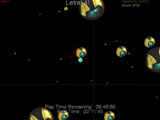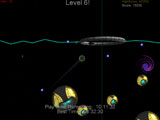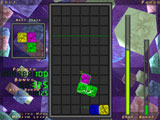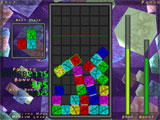One-Button Fun With Strange Attractors
Strange Attractors by Ominous Development was created for Retro Remakes’ One Switch Competition. It tied for sixth place in the competition, but has since been nominated as a finalist for game design in this year’s Independent Games Festival. Everything in the game is controlled by a single button. In Strange Attractors, this single button toggles in the influence of gravity between the player’s ship and everything else.
Gravity in Strange Attractors resembles planetary motion. Rather than a downwards force, each individual object has attraction to all other objects. The end result is a lot of orbital-like motion. Orbital motion is fairly intuitive to control, even though we don’t have a direct analog to it in our day-to-day lives.
I’m not entirely sure what the goal in Strange Attractors is, to be honest. I just launched right into the game without reading any documentation. You have a timer, though, so I suppose the goal is to get to the next stage before that timer expires. There are a lot of crazy little men floating around, too, and dashing their tiny bodies against other objects appears to increase your timer. Strange Attractors is definitely a suitable name, because the game itself is a little strange.
Despite the one-button controls, it is possible to control your ship with some degree of intention. It’s hard to exactly hit any target, but you can influence your motion to a general degree. The later levels introduce vortexes that will fling you around and drastically increase the number of large objects blocking your way.


(Strange Attractors Game Screenshots)
Playing Strange Attractors is a bizarre experience. I would recommend just launching right into the game. The first half of the fun is figuring out how to control your motion, and the second half of the fun is figuring out just what, exactly, is going on. Why are there little men floating everywhere, and why do they scream so?
If you’re looking for neat one-button game design that makes great use of physics, check out Strange Attractors. Or, if you’re looking for a game with a lot of tiny little men that say strange things before their inevitable demise, Strange Attractors is a good match for you, too.
Download the game here (25.0 MB) or over at Ominous Development’s site.
An interview with the developers of Strange Attractors is posted over at Gamedev.net for some insight into the game’s development.
Related Posts:
- List of Physics Games
- Beautiful, Frustrating Puzzle Physics
- Opposites Do Attract: + | –
- Trials 2SE Visual Upgrade, Same Great Physics
- Puppetteering Not So Fun After All
New Page: List of Physics Games
I added a new page available from the sidebar of the site: List of Physics Games. It’s an index of all of the games reviewed so far on the site. For those of you just discovering Fun-Motion this is a great way to look over all of the old posts at a glance.
Also new are the Related Posts links and the social bookmarking quick links for those of you who use del.icio.us, Digg, or one of the other online bookmark sites.
One-Part Tetris, One-Part Physics: Triptych
Triptych by Chronic Logic plays like a physically uninhibited version of drop-puzzlers like Tetris or Super Puzzle Fighter. The core premise from these games remains–you must align various falling pieces so that same-color blocks touch. Where games like Tetris rely on a fixed grid, though, Triptych utilizes free-moving physics. Pieces bounce, squish, and stack in irregular ways rather than perfectly aligning themselves.
Controls are keyboard based: arrow keys move your piece, and A/D rotates it left and right. You have a certain amount of time to place the current piece, after which it will drop by itself (you can also place space to drop the piece early). If the stack of blocks is too high at the end of your piece placement you lose. This is an interesting failure state, because you can actually mash the pieces down very quickly and then hit space to drop the piece. Technically the piece placement is valid even if the board quickly rebounds above the containment mark. Of course, at this point you need to very quickly figure out how to make room for the next piece.
I question the decision to use keyboard controls. As a player I’d much rather grab and throw pieces around with the mouse in a more intuitive fashion. I think the game would be faster-paced and much more accessible with mouse-only controls, too. Requiring a casual player to utilize 7 different keys to play the game is a bit demanding.
The game rules in Triptych are simple. When three blocks of the same color touch they will vanish. The game features a fairly standard combo system. If you make successive matches within a certain timeframe they count as a combo for increased points.
The biggest problem I have with Triptych is the game’s pacing. Stacking pieces into an empty playing field is fun, at first, but quickly becomes dull. The problem with the game is that things don’t get very interesting until the playing field is nearly full, and by this time you’re very near to failing. If the end-game pacing could somehow be elongated so that pressure could build at a slower pace I think the game would be a lot more enjoyable.
All things considered, Triptych is a neat implementation of the well-worn drop-puzzler genre. Physics really do spice things up and add to the game’s replayability. If you’ve ever wished you could mash pieces around and bend the rules in a game like Tetris definitely give Triptych a try.
A 4-level Triptych game demo is available here (1.60MB) or over at the Chronic Logic website (Windows, MacOS, Linux).
Related Posts:
- Gish 2 Announced!
- The Beginning
- Gish, The Father of Physics Platformers
- A Classic: Bridge Builder by Chronic Logic
- The Pinnacle of Breakout Games: BreakQuest






 My name is Matthew Wegner, and this site is dedicated to physics games.
My name is Matthew Wegner, and this site is dedicated to physics games.